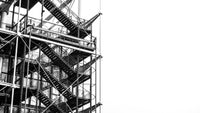The International Building Code (IBC) is a set of rules that make buildings safer, including how handrails should be built and installed. If you're a homeowner, contractor, or architect, following these rules helps keep people safe and avoids expensive mistakes. But what do the IBC code requirements have to do with handrails? Simply put, it’s a guide that makes sure stairways are safe to use—so it’s important to know the key rules if you're working with handrails.
Key IBC Handrail Code Requirements
-
Height Requirements: Handrails should be installed at a height between 34 and 38 inches above the stair tread nosing.
-
Handrail Diameter & Graspability: For circular handrails, the outside diameter must be between 1.25 and 2 inches. Non-circular handrails should have a perimeter dimension between 4 and 6.25 inches, with a maximum cross-sectional dimension of 2.25 inches.
-
Clearance: There must be a minimum clearance of 1.5 inches between the handrail and the wall to allow users to grasp the rail comfortably.
-
Projection Limits: Handrails can project no more than 4.5 inches into the required width of stairways and ramps.
-
Spacing Between Handrails: If a stairway is wider than 30 inches, additional intermediate handrails are required so that all portions of the stairway width are within 30 inches of a handrail.
As of 2025, these are the latest IBC handrail requirements, ensuring safety and compliance with the most up-to-date building codes.
Additional Handrail Specifications
-
Circular vs. Non-Circular Handrails:
-
Circular Handrails: Must have an outside diameter between 1.25 inches and 2 inches.
-
Non-Circular Handrails: Should have a perimeter between 4 inches and 6.25 inches, with a maximum cross-sectional dimension of 2.25 inches.
-
Larger Perimeter Handrails and Graspability: For handrails with a perimeter greater than 6.25 inches, they must include a graspable finger recess on both sides to ensure they can be easily held.
-
Handrail Extensions: Handrails should return to a wall, guard, or the walking surface. If not continuous between flights, they must extend horizontally at least 12 inches beyond the top riser and continue the slope for the depth of one tread beyond the bottom riser.
-
Handrail Continuity and Fittings: Handrails must be continuous along the stairs or ramp without interruptions by posts or other obstructions. They should also not rotate within their fittings.
-
Intermediate Handrails: For wider stairways, intermediate handrails are required so that all portions of the stairway width are within 30 inches of a handrail.
The Most Common Code Violations (and How to Fix Them)
-
Handrail is too high or too low (not between 34”-38”).
-
Handrail is too close to the wall (less than 1.5” clearance).
-
Handrail is too thick, too wide, or difficult to grip.
-
Handrail doesn’t extend properly at the top or bottom of the stairs.
-
Handrail projects more than 4.5” into the stairway path.
Looking at these common handrail mistakes, it’s clear that most could be avoided with a quick web search or by reviewing this article. But the real challenge comes when an existing handrail doesn’t meet these requirements—so what should you do then?
What to Do When Existing Handrails Don’t Meet IBC Code Requirements
-
Identify the Issue: Check height, clearance, graspability, projection, and continuity. Compare the measurements with the IBC handrail requirements (e.g., height must be 34"-38", clearance at least 1.5").
-
Decide if You Can Modify or Replace: If the brackets are too short, swap them out for longer ones. If the handrail is too high or low, try repositioning it. If the diameter or shape isn’t compliant, replacement is usually the best option.
-
Extend or Adjust Where Needed: If the handrail doesn’t extend properly according to the IBC requirements, attach an extension piece to meet the 12-inch top extension and one-tread-depth bottom extension requirement. If your stairs are wider than 30 inches, install an additional handrail in the middle.
-
Reinforce for Strength and Stability: Ensure the handrail is securely attached with strong brackets that support weight. If the handrail wobbles, check the anchors and screws, and replace or reinforce them as needed.
-
Consult Local Inspectors if Needed: If major changes are required, it’s best to check with local building inspectors before starting modifications. For public or commercial buildings, hiring a professional may be required to ensure full compliance.
Bottom Line:
If the handrail can be fixed with simple adjustments, do it. If not, replace non-compliant parts to meet IBC handrail standards and keep the space safe.
Conclusion:
IBC handrail codes exist for a reason—they keep stairways safe and accessible. Ignoring them can lead to safety hazards, failed inspections, and costly fixes down the road. While these codes provide a general standard, local regulations may have slight variations, so always check with your area’s building authority before making changes. Whether you're installing a new handrail or fixing an existing one, following these guidelines ensures compliance and, more importantly, safety.
Feel free to contact us if you need help choosing your perfect outdoor railing.









